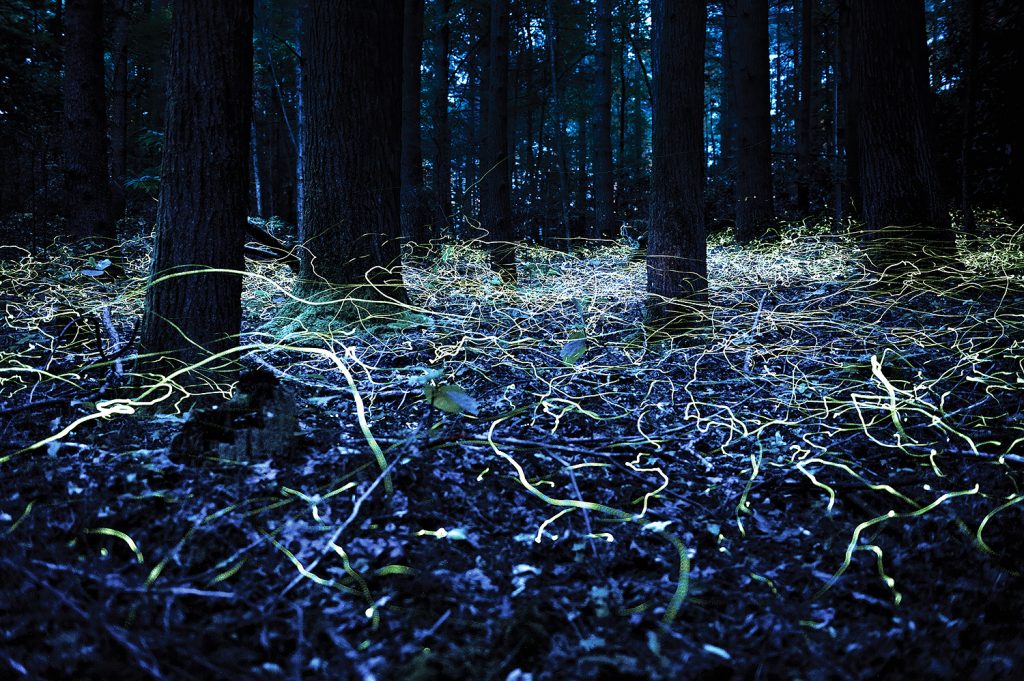
A time-lapse photo shows blue ghosts and other species of fireflies weaving through the dark forest floor in a type of courtship dance. Most of these bioluminescent species only live as adults for four or five weeks. Photo by Spencer Black
By Matt Dhillon
Something enchanting lives in Appalachia’s forests. From green glows to bright sparks, the lights of Appalachia bring summer nights to life.
A variety of living things produce light, or bioluminescence.
“There’re a lot of reasons for bioluminescence,” says Craig Guthrie, chief ranger at High Bridge State Park in Virginia, home of the annual Firefly Festival celebrating the insect. “There’re some that are just mysteries. Sometimes it’s thought that bioluminescence is a warning. It’s saying, ‘Hey, I’m not trying to hide and I’m not good to eat.’”
Some creatures use light to lure prey. Others use it to communicate. Bioluminescence can be seen in a variety of colors, intensities and patterns, but there is one reliably consistent feature — chemistry.
“It has two main chemicals, there is a biochemical called luciferin — it’s named after Lucifer the angel of light — and an enzyme called luciferase,” says Guthrie. “When the luciferase breaks the luciferin molecule, it releases energy from that chemical bond and the form of that energy is bioluminescent light.”
On a molecular level, this process is at the core of almost all bioluminescence. From luminous jellyfish to hanging cave larvae, the interaction between luciferin and luciferase is taking place. Still, the light they produce takes many unique forms.
Here’s what you might find if you chase the light in Appalachia.
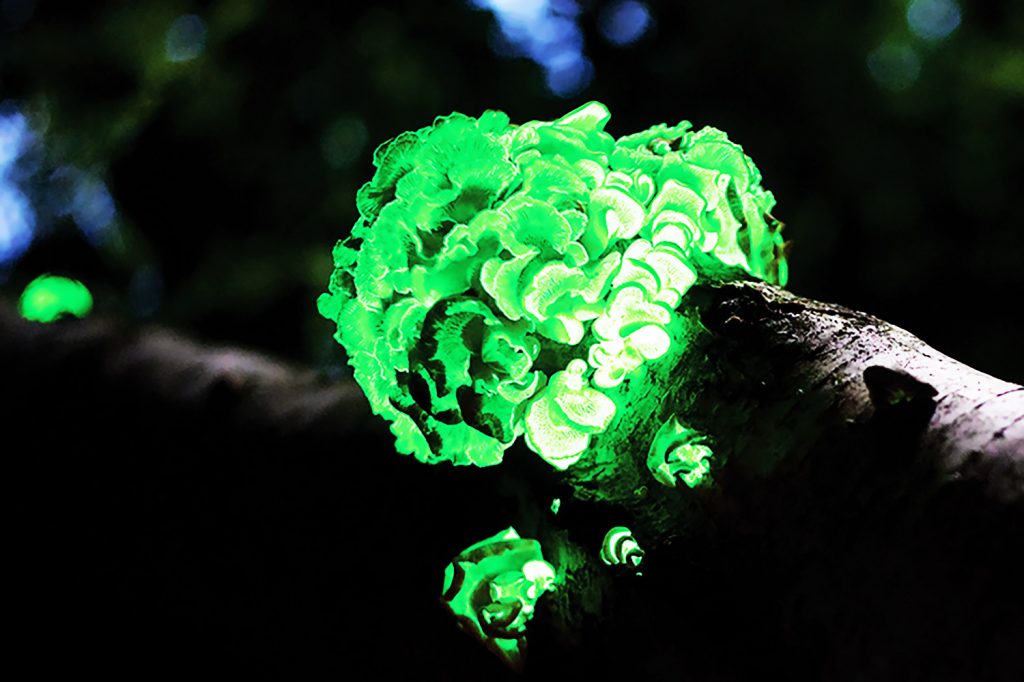
Foxfire can be seen in patches on the forest floor, radiating from rotten wood, or attached to the bases of trees. Foxfire includes a variety of species of bioluminescent fungi, like this clump of bitter oyster mushrooms. Photo by Ylem
Foxfire
Foxfire is one of the oldest bioluminescent curiosities, described by Aristotle as a cold fire. An eerie, emerald light that can be seen in patches on the forest floor, radiating from rotten wood or attached to the bases of trees, foxfire has been called “false fire” and is sometimes attributed to the locations where fairies make their nightly revels.
On closer inspection, its source is found to be bioluminescent fungi. Among them are honey mushrooms, jack-o-lanterns, dripping bonnets and bitter oysters.
It’s not clear why they glow, though a 2015 study in Current Biology theorizes that it’s to attract insects that can spread their spores, making them the street lights and porch lights of the forest floor. Foxfire glows only at night, with a continuous green light, which implies that the process is regulated. The same study suggests that the release of luciferin in mushrooms is guided by circadian rhythms. Other theories hold that the mushrooms glow as a warning, to show that they are toxic or unpalatable.
Neither theory conclusively explains why the fungi glow. But they do, haunting rotting logs and bark with their ghostly light. Foxfire can vary in intensity, but some observers report it is bright enough to read by. A Scandinavian tradition is to use oak bark imbued with foxfire to mark trails in the dark so that those venturing in the forest can find their way back.
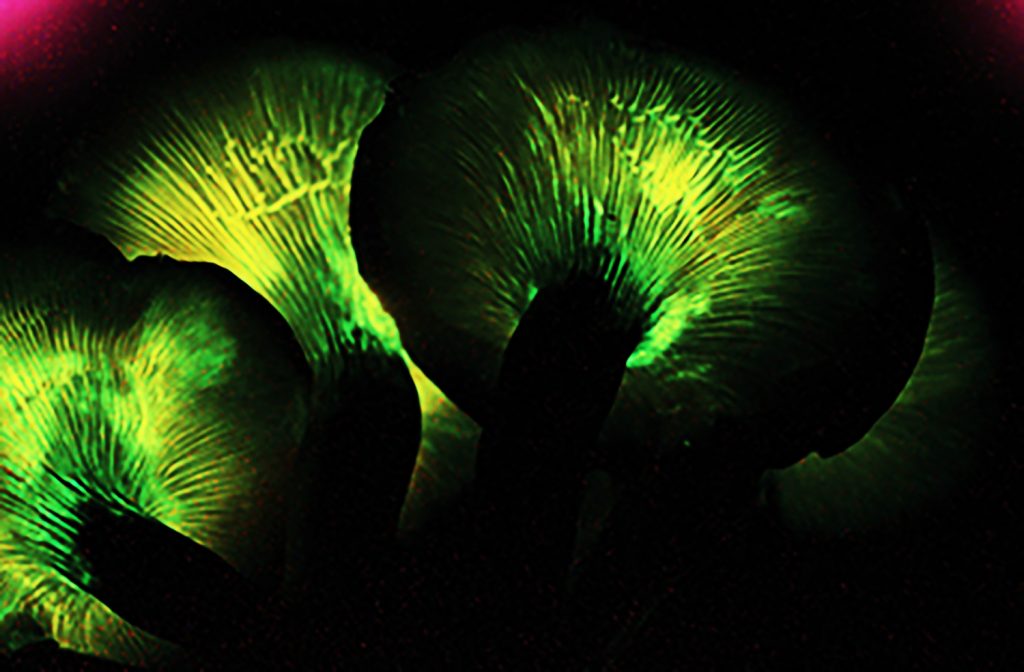
Jack o’lantern mushrooms, a species of foxfire glows green in Appalachian forests at night. Photo by Noah Siegel
The light is reported to be durable, lasting for days when taken indoors. Foxfire was even used to light the needles on the barometer and compass of an early submarine, the Turtle, built in 1775 to break the British blockade of Boston Harbor. And yes, the school-age authors of Foxfire Magazine, which became a series of books about Southern Appalachian heritage, took the publication name from the glowing fungus.
Fireflies
Few things are as closely linked to light as fireflies. The eggs produce light, as do the larvae and pupae, and they emerge as adults with a specific organ for blinking.
One of the iconic signs of summer is watching fields and forests gradually fill with their sparks, like embers from a low fire. Fireflies float up from vegetation in meadows and forest floors as far as the crowns of trees, turning grassy fields into a cosmos of reachable constellations.
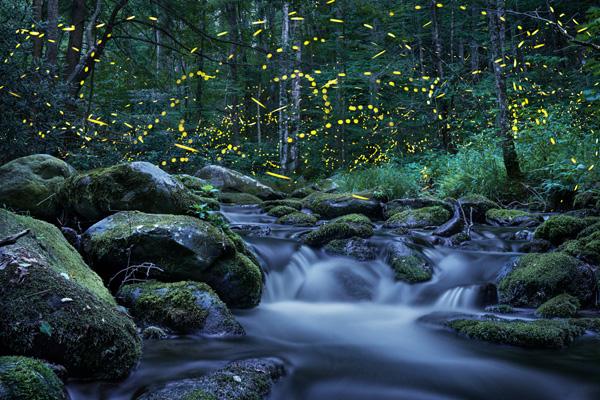
Synchronous and blue ghost fireflies leave luminescent trails above a stream in the Smoky Mountains in this time-lapse image of the insect’s flickering, summertime courtship ritual. Photo by Radim Schreiber
The display is meant to be seen. Fireflies use their lightbulb-like organs to communicate. The summer months, especially June, are mating season for fireflies, and the essential purpose of their bursts of light is to find each other in the dark.
“There’s an amazing number of fireflies in our area,” says Guthrie. “Generally, in a given area, there might be somewhere between 25 to 50 species.”
“Some species of fireflies will flash in a series of three flashes that are rapid,” Guthrie says. “Others may make a long flash, and they’ll dip their whole bodies and kind of make that J shape in the night sky, and that’s specific to that species. When the females are watching, they’ll have a response that’s appropriate to that species, and then they can find each other to mate.”
In parts of Appalachia including the Smoky Mountains, a species called Photinus carolinus has adapted so that the males tune their flashes together and eventually align to produce coordinated pulses of light. Other species are distinguished by their color. Rare blue ghost fireflies emit a haunting blue-white light that they can hold for up to a minute and are said to be the wandering souls of fallen soldiers.
“We’ll never get into the mind of a bug,” says Guthrie. “But the females are selective. They select a male that they think has its act together.”
Perhaps for this reason, the bulb of a firefly is incredibly refined.
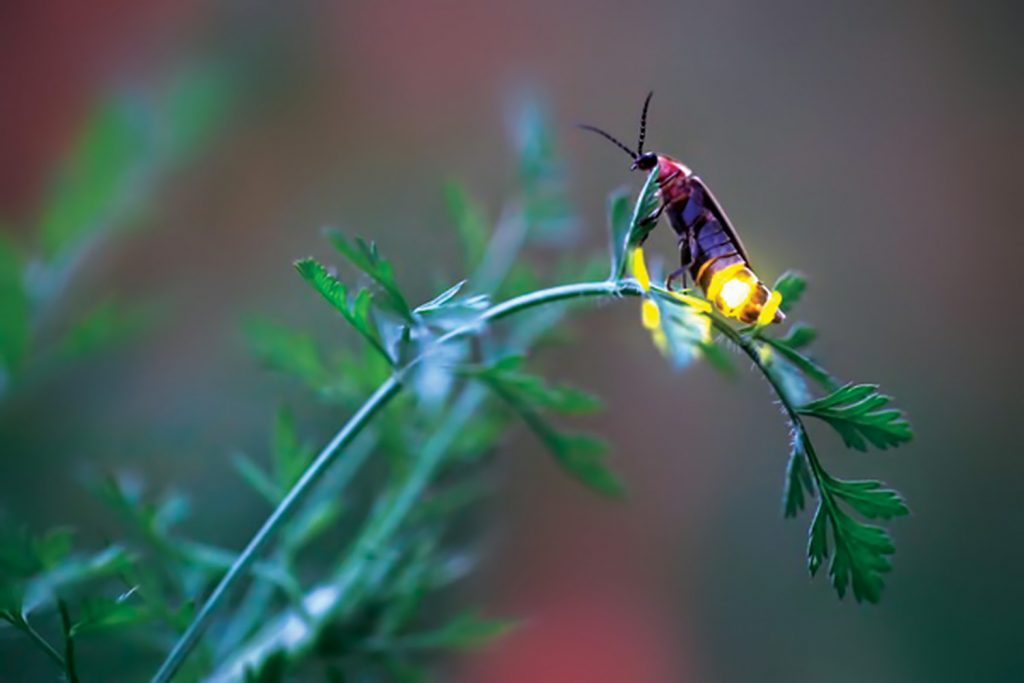
The Firefly’s lightbulb-like organ, as seen on this eastern firefly, Photinus pyralis, is the most sophisticated light-producing organ of any nown bioluminescent creature on Earth. Photo by Radim Schreiber
“It’s the most sophisticated light-producing organ of any known bioluminescent creature on Earth,” says Guthrie. “They are super efficient. They have been the envy of human endeavor, how efficiently they can produce light. It’s something around 90% light, where an incandescent bulb produces about 90% heat and 10% light.”
Most species only live as adults for four or five weeks. For many, it’s less. Summertime is for finding a mate. Most species don’t even eat as adults.
“The longest-lived stage of a firefly is the larva, which we call glow worms,” says Guthrie. This can be one to two years of their life.
“This stage is highly predacious. They don’t eat plants, they’re not a pest. They control things like small worms, small snails — any small insect that’s smaller than themselves they’ll tackle and they’ll eat it.”
This is when they’re most vulnerable. Habitat loss from construction and development are the biggest threats to firefly populations, Guthrie says. As wetlands go out, so do the lights of fireflies. The biggest impact is seen in species diversity, since there are so many species localized to specific habitats.
Light pollution is also thought to interfere with firefly behavior. Researchers at the University of Virginia have collected data that suggest that fireflies flash less and are less likely to mate in the presence of artificial light.
For humans and fireflies to cohabitate, firefly advocates suggest cultivating native plants, not over-mowing lawns, turning off outside lights when not in use, and especially avoiding the use of pesticides.
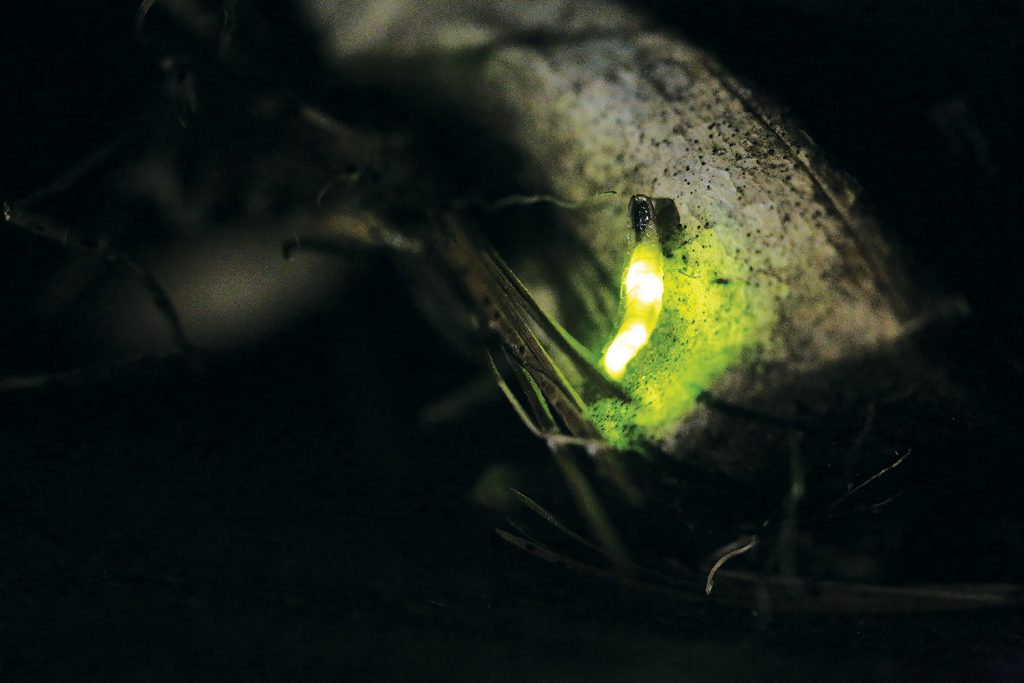
Female blue ghost fireflies resemble larvae. They appear bright green up close, but appear to glow blueish-white from a distance. Photo by Radim Schreiber
Fungus Gnats
A more secretive illumination comes from the larvae of a species of fungus gnat, Orfelia fultoni. The worm lives on riverbanks, rocky crevices and in caves of Southern Appalachia.
The larvae are carnivorous, weaving sticky webs to catch small flying insects, and the icy blue needles of light they produce is among the most brilliant blue of any bioluminescent insect. Their light is thought to lure insects into their webs.
Researchers isolated and reproduced the process by which the larvae glow, expecting to use bioluminescence in biotech applications aimed at understanding human diseases.
Spectators don’t have to go so far to catch the light in Appalachia, provided they know where to look. A number of parks offer guided night events to view the firefly spectacle, including sightings of blue ghost and synchronous varieties. And it’s worth a nighttime wander to find out whether they might live in your own backyard.
Related Articles
Latest News
More Stories

Leave a comment
Your email address will not be published. Required fields are marked *
One response to “Chasing the Light of Bioluminescence”
-
Very interesting, thank you for this article! Fireflies are cool!





Leave a Comment